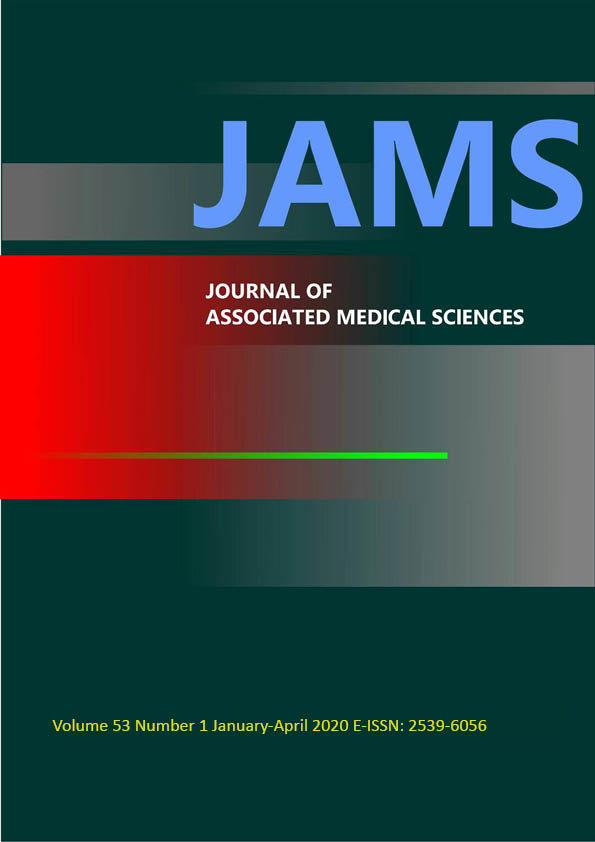Biomechanical differences between sit-to-stand performances using one leg and two legs in young adults
Main Article Content
Abstract
Background: Sit-to-stand (STS) test is widely used as a functional test for the assessment of lower extremity function in the elderly. Performing the STS movement with one-leg was introduced as an assessment of lower extremity muscle strength in young adults; however, the biomechanical differences between the traditional two-leg STS movement and one-leg STS movement have not been reported. The purposes of this study were to characterize and compare the kinematic and kinetic differences between the one-leg and two-leg STS movements.
Materials and methods: Fifteen young adults (8 men and 7 women) with mean age 26.18±3.88 years participated in this study. The kinematic and kinetic data during one-leg and two-leg STS testing conditions were collected and analyzed using force plates and a three-dimensional motion analysis system.
Results: Performance time was significantly longer in the one-leg STS condition than the two-leg STS condition (p<0.001). The peak joint angular positions of the hip, knee, and ankle were not different between the two STS testing conditions. All kinetic variables of the one-leg STS condition were significantly higher than those of the two-leg STS condition (p<0.05), except peak knee joint power in the concentric phase.
Conclusion: The more demanding task of the one-leg STS condition led to several changes in the joint moment and joint power of the lower extremity. The hip extensor and ankle dorsiflexor muscles demonstrated significant roles in addition to the knee extensor muscles during the one-leg STS task.
Article Details

This work is licensed under a Creative Commons Attribution-NonCommercial-NoDerivatives 4.0 International License.
Personal views expressed by the contributors in their articles are not necessarily those of the Journal of Associated Medical Sciences, Faculty of Associated Medical Sciences, Chiang Mai University.
References
Bohannon RW, Bubela DJ, Magasi SR, Wang YC, Gershon RC. Sit-to-stand test: Performance and determinants across the age-span. Isokinet Exerc Sci 2010; 18(4): 235-40.
McCarthy EK, Horvat MA, Holtsberg PA, Wisenbaker JM. Repeated chair stands as a measure of lower limb strength in sexagenarian women. J Gerontol A Biol Sci Med Sci 2004; 59(11): 1207-12.
Wang TH, Liao HF, Peng YC. Reliability and validity of the five-repetition sit-to-stand test for children with cerebral palsy. Clin Rehabil 2012; 26(7): 664-71. doi: 10.1177/0269215511426889.
Mong Y, Teo TW, Ng SS. 5-repetition sit-to-stand test in subjects with chronic stroke: reliability and validity. Arch Phys Med Rehabil 2010; 91(3): 407-13. doi: 10.1016/j.apmr.2009.10.030.
Wheeler J, Woodward C, Ucovich RL, Perry J, Walker JM. Rising from a chair. Influence of age and chair design. Phys Ther 1985; 65(1): 22-6.
Ekdahl C, Andersson SI, Svensson B. Muscle function of the lower extremities in rheumatoid arthritis and osteoarthrosis. A descriptive study of patients in a primary health care district. J Clin Epidemiol 1989; 42(10): 947-54.
Ostenberg A, Roos E, Ekdahl C, Roos H. Isokinetic knee extensor strength and functional performance in healthy female soccer players. Scand J Med Sci Sports 1998; 8(5 Pt 1): 257-64.
Tapanya W, Chamnongkich S. Relationship between lower limb muscle strength and single-leg sit-to-stand performance in young adults. Bull Chiang Mai Assoc Med Sci 2014; 47(3): 133-42.
Yoshioka S, Nagano A, Hay DC, Fukashiro S. Biomechanical analysis of the relation between movement time and joint moment development during a sit-to-stand task. Biomed Eng Online 2009; 8: 27. doi: 10.1186/1475-925X-8-27.
Gross MM, Stevenson PJ, Charette SL, Pyka G, Marcus R. Effect of muscle strength and movement speed on the biomechanics of rising from a chair in healthy elderly and young women. Gait Posture 1998; 8(3): 175-85.
Yoshioka S, Nagano A, Hay DC, Fukashiro S. Peak hip and knee joint moments during a sit-to-stand movement are invariant to the change of seat height within the range of low to normal seat height. Biomed Eng Online 2014; 13: 27. doi: 10.1186/1475-925X-13-27.
Yoshioka S, Nagano A, Himeno R, Fukashiro S. Computation of the kinematics and the minimum peak joint moments of sit-to-stand movements. Biomed Eng Online 2007; 6: 26. doi: 10.1186/1475-925X-6-26.
Kerr KM, White JA, Barr DA, Mollan RA. Analysis of the sit-stand-sit movement cycle in normal subjects. Clin Biomech (Bristol, Avon) 1997; 12(4): 236-45.
Chamnongkich S, Wongsaya E, Sirirurdpaishan P. Trunk displacement during the sit-to-stand tests in young adults. Bull Chiang Mai Assoc Med Sci 2013; 46(2): 131-9.
Vicon-Motion-Systems Ltd. Plug-In Gait: Oxford: Oxford Metrics Ltd; 2010.
Velotta J, Weyer J, Ramirez A, Winstead J, Bahamonde. Relatiosnhips between leg dominance tests and type of task. Portugese J Sport Sci 2011;11:1035-8.
Savelberg HH, Fastenau A, Willems PJ, Meijer K. The load/capacity ratio affects the sit-to-stand movement strategy. Clin Biomech (Bristol, Avon) 2007; 22(7): 805-12.
Toda H, Nagano A, Luo Z. Age and gender differences in the control of vertical ground reaction force by the hip, knee and ankle joints. J Phys Ther Sci 2015; 27(6): 1833-8.
Kellis E, Arambatzi F, Papadopoulos C. Effects of load on ground reaction force and lower limb kinematics during concentric squats. J Sports Sci 2005; 23(10): 1045-55.
Dali S, Justine M, Ahmad H, Othman Z. Comparison of ground reaction force during different angle of squatting. J Hum Sport Exerc 2013; 8(3): 778-87.
Goulart FR, Valls-Solé J. Patterned electromyographic activity in the sit-to-stand movement. Clin Neurophysiol 1999;110(9):1634-40.
Kotake T, Dohi N, Kajiwara T, Sumi N, Koyama Y, Miura T. An analysis of sit-to-stand movements. Arch Phys Med Rehabil 1993; 74(10): 1095-9.
Yoshioka S, Nagano A, Hay DC, Fukashiro S. Peak hip and knee joint moments during a sit-to-stand movement are invariant to the change of seat height within the range of low to normal seat height. Biomed Eng Online 2014; 13(1): 27. doi: 10.1186/1475-925X-13-27.
Abdolrahmani, Yonetsu R. Coordination between trunk and ankle during sit-to-stand task in healthy young subjects. J Rehabil Health Sci 2015; 13: 1-5.
Steingrebe H, Stein T, Bös K, Hoffmann K. Biomechanical analysis of the knee joint load during a unilateral sit-to-stand movement. Open Sports Sci J 2018; 11(81): 78-86. doi: 10.2174/1875399X01811010078.

